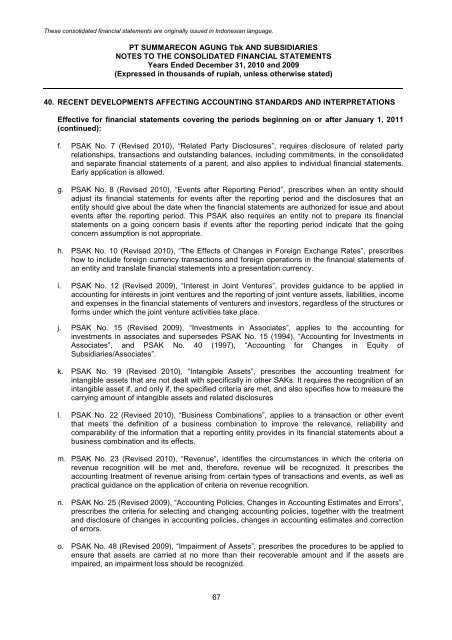PT Summarecon Agung Tbk | Laporan Tahunan 2010 Annual Report
PT Summarecon Agung Tbk | Laporan Tahunan 2010 Annual Report
PT Summarecon Agung Tbk | Laporan Tahunan 2010 Annual Report
Create successful ePaper yourself
Turn your PDF publications into a flip-book with our unique Google optimized e-Paper software.
These consolidated financial statements are originally issued in Indonesian language.<br />
<strong>PT</strong> SUMMARECON AGUNG <strong>Tbk</strong> AND SUBSIDIARIES<br />
NOTES TO THE CONSOLIDATED FINANCIAL STATEMENTS<br />
Years Ended December 31, <strong>2010</strong> and 2009<br />
(Expressed in thousands of rupiah, unless otherwise stated)<br />
40. RECENT DEVELOPMENTS AFFECTING ACCOUNTING STANDARDS AND INTERPRETATIONS<br />
Effective for financial statements covering the periods beginning on or after January 1, 2011<br />
(continued):<br />
f. PSAK No. 7 (Revised <strong>2010</strong>), “Related Party Disclosures”, requires disclosure of related party<br />
relationships, transactions and outstanding balances, including commitments, in the consolidated<br />
and separate financial statements of a parent, and also applies to individual financial statements.<br />
Early application is allowed.<br />
g. PSAK No. 8 (Revised <strong>2010</strong>), “Events after <strong>Report</strong>ing Period”, prescribes when an entity should<br />
adjust its financial statements for events after the reporting period and the disclosures that an<br />
entity should give about the date when the financial statements are authorized for issue and about<br />
events after the reporting period. This PSAK also requires an entity not to prepare its financial<br />
statements on a going concern basis if events after the reporting period indicate that the going<br />
concern assumption is not appropriate.<br />
h. PSAK No. 10 (Revised <strong>2010</strong>), “The Effects of Changes in Foreign Exchange Rates”, prescribes<br />
how to include foreign currency transactions and foreign operations in the financial statements of<br />
an entity and translate financial statements into a presentation currency.<br />
i. PSAK No. 12 (Revised 2009), “Interest in Joint Ventures”, provides guidance to be applied in<br />
accounting for interests in joint ventures and the reporting of joint venture assets, liabilities, income<br />
and expenses in the financial statements of venturers and investors, regardless of the structures or<br />
forms under which the joint venture activities take place.<br />
j. PSAK No. 15 (Revised 2009), “Investments in Associates”, applies to the accounting for<br />
investments in associates and supersedes PSAK No. 15 (1994), “Accounting for Investments in<br />
Associates”, and PSAK No. 40 (1997), “Accounting for Changes in Equity of<br />
Subsidiaries/Associates”.<br />
k. PSAK No. 19 (Revised <strong>2010</strong>), “Intangible Assets”, prescribes the accounting treatment for<br />
intangible assets that are not dealt with specifically in other SAKs. It requires the recognition of an<br />
intangible asset if, and only if, the specified criteria are met, and also specifies how to measure the<br />
carrying amount of intangible assets and related disclosures<br />
l. PSAK No. 22 (Revised <strong>2010</strong>), “Business Combinations”, applies to a transaction or other event<br />
that meets the definition of a business combination to improve the relevance, reliability and<br />
comparability of the information that a reporting entity provides in its financial statements about a<br />
business combination and its effects.<br />
m. PSAK No. 23 (Revised <strong>2010</strong>), “Revenue”, identifies the circumstances in which the criteria on<br />
revenue recognition will be met and, therefore, revenue will be recognized. It prescribes the<br />
accounting treatment of revenue arising from certain types of transactions and events, as well as<br />
practical guidance on the application of criteria on revenue recognition.<br />
n. PSAK No. 25 (Revised 2009), “Accounting Policies, Changes in Accounting Estimates and Errors”,<br />
prescribes the criteria for selecting and changing accounting policies, together with the treatment<br />
and disclosure of changes in accounting policies, changes in accounting estimates and correction<br />
of errors.<br />
o. PSAK No. 48 (Revised 2009), “Impairment of Assets”, prescribes the procedures to be applied to<br />
ensure that assets are carried at no more than their recoverable amount and if the assets are<br />
impaired, an impairment loss should be recognized.<br />
67


